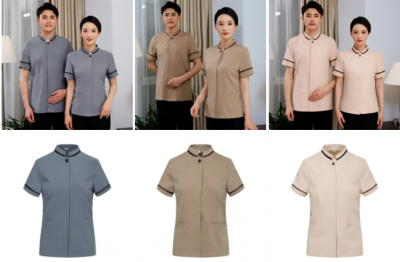Color emotions play a significant role in uniform design, as colors have the ability to evoke specific feelings, attitudes, and perceptions in people. The selection of colors for uniforms can influence how individuals perceive the wearer, convey a sense of identity or belonging, and even impact their performance and behavior. Here’s how the power of color emotions comes into play in uniform design:
- Identity and Branding: Colors are often associated with certain emotions and characteristics. Organizations can use specific colors in their uniforms to reinforce their brand identity and values. For instance, a healthcare institution might choose calming and trustworthy colors like blue and white to convey a sense of professionalism and reliability.
- Team Unity: Uniforms help create a sense of unity and belonging among team members. Colors that evoke feelings of camaraderie, such as warm tones like red and orange, can foster a strong sense of teamwork and cooperation among wearers.
- First Impressions: The colors chosen for uniforms can influence how people perceive the wearers. Bright and bold colors may exude confidence and energy, while more subdued colors might convey a sense of professionalism and seriousness.
- Psychological Impact: Different colors can have psychological effects on individuals. For example:
- Red: Associated with energy, passion, and urgency. It can stimulate adrenaline and increase heart rate.
- Blue: Evokes calmness, trust, and reliability. It is often used in industries where a sense of security is crucial.
- Green: Represents growth, health, and harmony. It can create a sense of balance and relaxation.
- Yellow: Radiates positivity, happiness, and optimism. It can grab attention and boost mood.
- Black: Symbolizes sophistication, elegance, and authority. It can create a sense of formality.
- White: Signifies purity, cleanliness, and simplicity. It can give an impression of neutrality.
- Functional Considerations: Uniforms aren’t just about aesthetics; they also need to be functional. Color choices can impact practical aspects like visibility and safety. High-visibility colors like fluorescent yellow or orange are often used in safety uniforms to ensure wearers are easily seen.
- Cultural and Contextual Sensitivity: Colors can have different cultural meanings and associations. Designers must be mindful of the cultural context in which the uniforms will be worn to avoid unintentionally conveying the wrong message or causing offense.
- Customer Interaction: In service industries, uniform colors can affect customer perception. Warm and approachable colors might make customers feel more at ease, while cooler tones can communicate professionalism.
- Emotional Resonance: The emotional connection people have with certain colors can positively affect their attitude and performance. For example, athletes wearing uniforms in colors they associate with strength and determination might perform better.
- Consistency and Recognition: Consistency in uniform colors can contribute to easy recognition of a brand or organization. Over time, customers and the general public can come to associate specific colors with a particular entity.
In conclusion, the power of color emotions in uniform design goes beyond aesthetics. It involves a deep understanding of the psychological and cultural implications of color choices. By leveraging color psychology effectively, uniform designers can influence perceptions, emotions, and behaviors, ultimately contributing to the overall success of the organization or team.

































